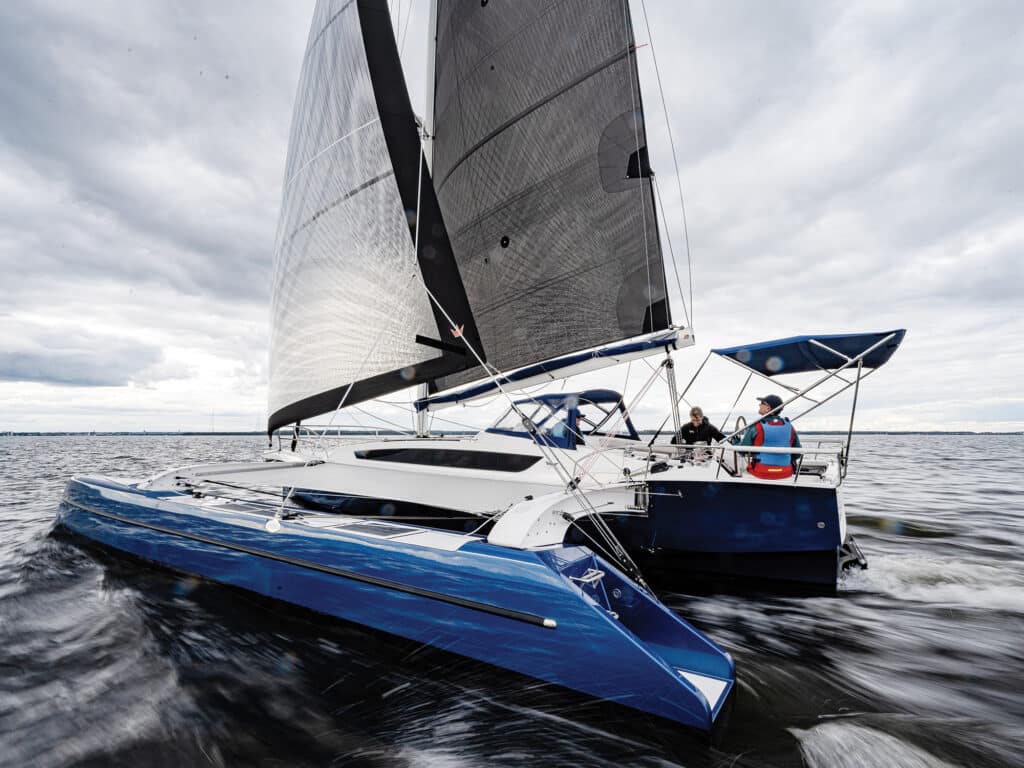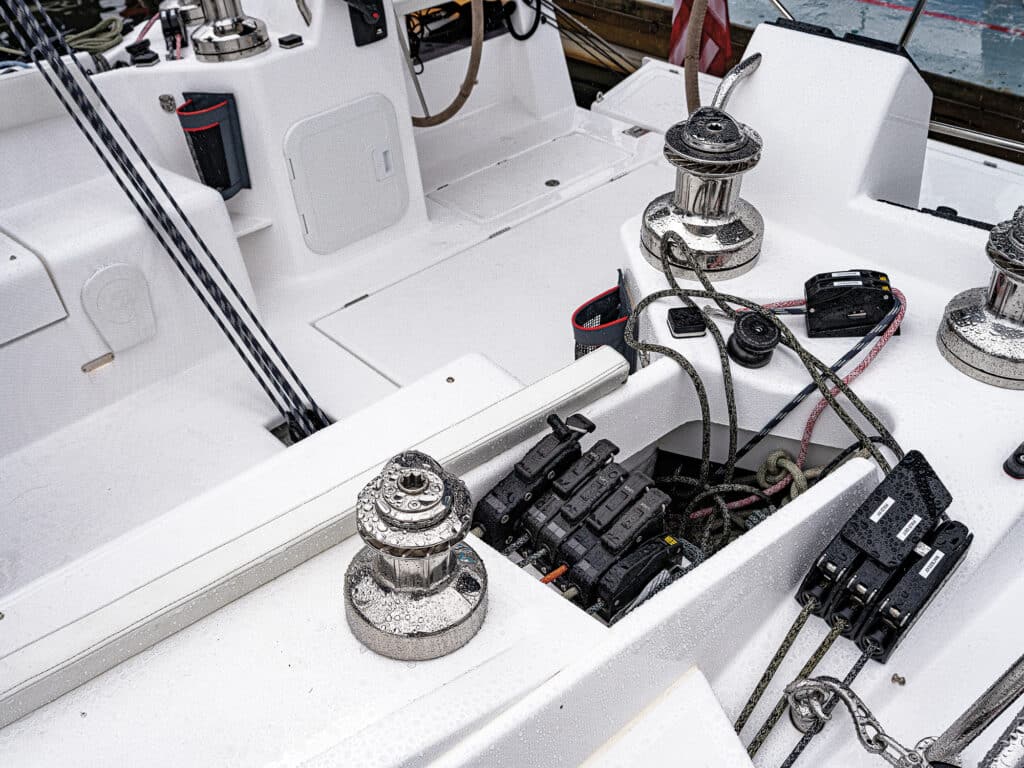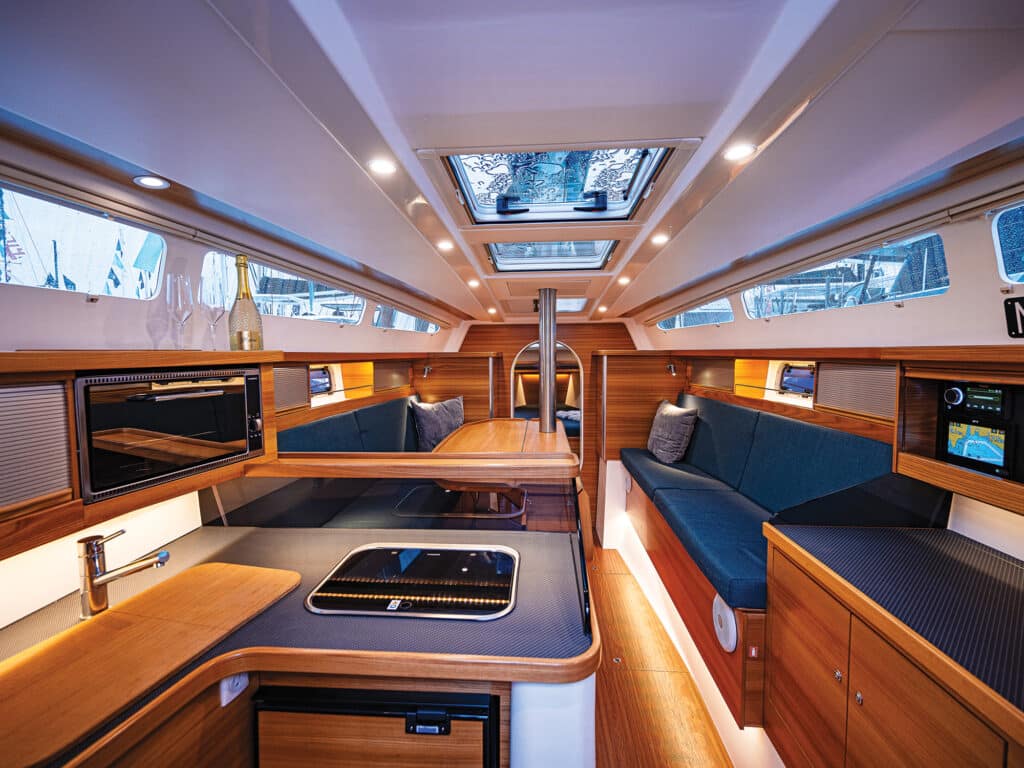
“Classy.” That was the first word that came to mind for Boat of the Year judge Mike Ingham when he stepped aboard the formidable 40-foot trimaran from Dragonfly, an unexpected and welcome late entry to the competition in Annapolis. “It almost feels as if the boat is intentionally understated but overdelivered because once you start looking closer at the details and craftsmanship, it just keeps getting more impressive.”
Builder and company owner Jens Quorning, whose family has been building trimarans in southern Denmark since 1967, says the Dragonfly 40 is the biggest boat they now build and a worthy holder of the flagship title. “Building a boat of this scale is complicated,” he says of the folding trimaran. “It takes three years to develop a new design, and this is for owners looking for a bigger boat, with better performance, capable of more long-distance sailing.”
The result is a powerful trimaran aimed at experienced owners who appreciate the sheer pleasure of racing and cruising on three hulls. This is not your average production multihull. It is a powerful and luxurious sailing machine capable of knocking off fast miles in comfort. Slip down below and you’re immediately immersed in a master class of woodwork and joinery. There are berths for four, including a giant master under the cockpit, plenty of standing headroom, and a comfortable salon and galley arrangement that’s monohull-cozy. “We do not offer a big house on the water,” Quorning tells the judges. “But if you really want a fine and elegant yacht with double-digit sailing, this is what we do.”
For our tests, Dragonfly presented its Ultimate edition, the midrange version. An upscaled Performance model is an all-carbon version with a taller mast. And in the lightest wind of the week, sub-10 knots, the trimaran teased the judges with its potential. Still, in the light stuff, the boat delivered a winning experience.

“It was a dream to sail upwind and downwind, almost effortlessly,” Ingham says. “With the gennaker up, at about 100 degrees true, we were going faster than the wind, and with winch pods on each side of the steering wheel, everything was as ergonomic as you could possibly imagine. The electric winches made it a cinch to furl and unfurl the headsails through the tacks and jibes, and the sails trimmed in perfectly every time.”
The feather-light feel of the helm, Ingham adds, was as smooth as a balanced dinghy. “With tiny movements on the wheel, the boat would immediately respond, but I could also walk away from the helm for a few minutes and the boat would stay right on track. Crazy—I think it steered itself better than I did.”
That’s the trait of a good trimaran, Greg Stewart says. The Dragonfly 40 has a lot of buoyancy in the bows, and while the center hull is substantial, the tall trussed rig and square top mainsail provide plenty of power. “The biggest thing that struck me is how easily accessible everything is,” Stewart says. “Clearly, every detail is painstakingly thought out, and I can’t believe how beautifully built the interior is. It’s top-notch, from the glasswork to the paintwork inside and out. Down below, we were all blown away by the finish.”
There’s no denying the boat is expensive at upward of $1 million, but the test boat had quality race sails, a full electric-winch package, and a long list of high-spec extras. At nearly 15,000 pounds light, it’s a substantial boat—not trailerable, but foldable with Dragonfly’s trademark technique that Corning describes as mimicking parallel rules. The floats are 2 feet longer than the center hull, with buoyancy pushed well forward into the reversed bows, and the center hull is narrow at the waterline before sweeping upward to a high and hard chine. This pronounced hull shape allows for the generous amount of headroom, and high bench seats that flank a long centerline table, which can, of course, drop down to create a double-size berth.

Allen noted that the center hull’s wide side decks provide a secure pathway to the bow, rather than across the trampolines. He was also impressed with the ease of sailing the boat and the comfort belowdecks. “When we were doing 9 knots, I went below and there was silence. It’s comfortable and beautiful. It would be a blast to do some long point-to-point racing on it, doublehanded or with like a crew of four, max.”
Stewart agreed, adding that beyond its noteworthy gunkholing attributes, the engine is well aft on the center hull, allowing it to be motored safely into shallow anchorages. The daggerboard is mechanically raised into the trunk, and the rudder kicks up. “I also think it would be great for a distance race or rally type of event,” Stewart says. “Its performance and versatility are what appeal to me, but the build quality is what really sets it apart.”









